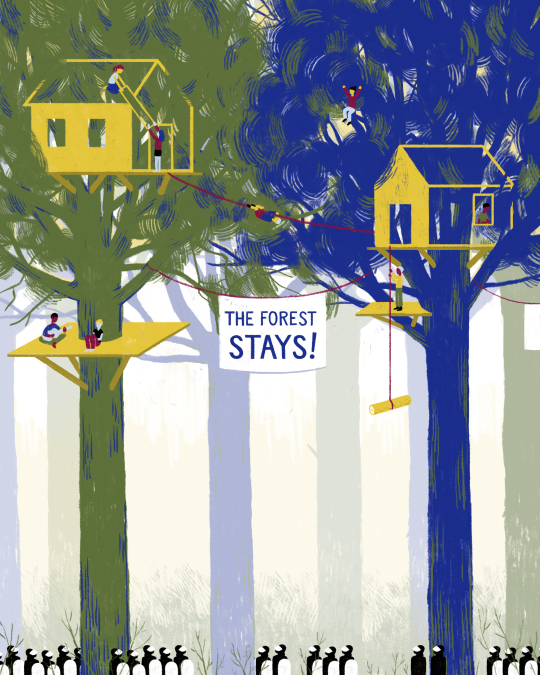Until the last tree falls

I feel helpless. Frustrated. Sad. Angry. I sit in my little self-made treehouse watching the forest around me disappear.
I walk through one of the biggest tracks of the forest. I walk fast to gain some heat. In the last few days, the temperature dropped, and I can now see my own breath becoming a little plume of smoke right in front of my face. It is still early morning, and I enjoy the stillness of the rising day. Only a few people pass me; we exchange greetings and everyone quickly continues their own way. The forest is big, and one can easily take the wrong turn and get lost. I tried to remember special marks on the trees – a strange looking branch, an uncommon junction of the stem – which would help me find my way.
I am now deep inside the forest. The trees around me are thick and tall; their long branches stretching towards the sky. Some of them are very old, carrying hundreds of years on their shoulders. Others are still small, slowly working their way through their parents’ shadows in search of some rays of sunshine. I came here some weeks ago. Like others around me, we are all here to fight for the forest’s survival. The chances are small (we all know that), and yet we don’t want to give up without at least articulating our anger and sadness. We want to show that we don’t agree with the political decision to cut a swath through this beautiful old-growth forest in the middle of a worldwide climate crisis. Our hope is to disturb and delay the devastation process as long as possible with our own bodies and the building of strategic treehouses and other structures. There are a variety of spontaneous and planned actions to interrupt the deforestation process.
I arrive at the juncture where I must turn left. I want to visit a friend in another barrio, referring to an accumulation of treehouses in one spot where a group of people has established itself. Usually, barrios have their own names and some particularities which make them distinguishable. My friend is building her treehouse in the crown of a middle-aged beech, and I want to see her, help a bit if I can, and exchange some news. The last days have been uncertain. There is always the fear of eviction, and anticipating it wears us all down even more. For days there have been rumors that police are coming the next day but, until now, they’ve all been false alarms. In “our” barrio, it is still quiet, and eviction does not yet seem like an imminent danger. Just kilometers away, however, the cutting continues with force and the permanence of it nears. My partner and I want to move closer to the cutting area to support the people there and help them build new treehouses.
I enter my friend’s barrio. The sun shines through the crowns of the trees, illuminating the little houses between them. I smell the fresh soil. I hear the birds singing and the rustling of leaves covering the ground. It seems surreal that, in less than one month, this place will no longer exist, that it will be lost to another asphalted highway, as if we didn’t have enough of those already…
——- 1 week later ——-
The howling of the chainsaws wakes me up. Helicopters flying over the forest area in which my partner and I have now been living for one week. I can hear police officers shouting through their microphones asking the activists to climb down the trees. My partner and I peek out of our treehouse, which we call Tango. Above our treehouse, the old oak splits into two main stems which looks to us like dancing people. Some 20 meters below we can see groups of activists moving through the thicket. From our treehouse we cannot see too far, but the machines quickly come closer. The sound of the chainsaws gets louder and louder, and soon we can see the first trees fall. The workers are not allowed to cut too close to the occupied trees so they start by cutting around them, leaving just some small tree islands. Not far from Tango stands another very old, big tree. We can see the workers approaching it. Moaning and groaning, the tree tries to withstand the saws which mercilessly keep cutting through the simultaneously strong yet vulnerable trunk. The moaning and cracking becomes a scream when it can no longer support itself, and the tree and trunk separate. A breathtaking silence follows as the brave, majestic tree falls to the ground in slow motion. The sound the tree makes before falling to the ground, dying, burns itself into my memory.
I feel helpless. Frustrated. Sad. Angry. I sit in my little self-made treehouse watching the forest around me disappear. It is just not fair that this forest, a home to many other species, must give way to societal obsession for more. Today society’s appetite for destruction proves stronger than our bond with nature. Here I can no longer feel hope and I slowly lose sight of what a better, more sustainable future looks like. The scene reminds me of a war zone. Why don’t they just stop? How can the authorities allow or (worse yet) instigate such destruction? One tree gives way to another, as the machines and the people slowly cut their way through the forest, leaving behind a dead environment, without question, without compassion, without even noticing, really, they are leading a death march. Until the last tree falls.
Story by a German activist who does not wish to appear by name to avoid problems with law enforcement. The Climate Illusrated team knows the activist’s identity and admire their courage to stand up for nature.
Art by Luise Hesse @lufie.nesse. Luise is a German illustrator and part of Climate Illustrated’s art team.